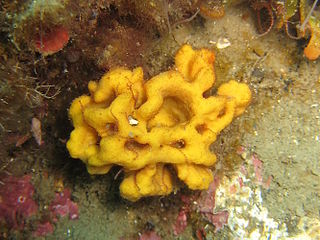
Geodia is a genus of sea sponge belonging to the family Geodiidae. It is the type genus of its taxonomic family.

Henry John Carter, FRS was a surgeon working in Bombay, India, who carried out work in geology, paleontology, and zoology. He worked as an army surgeon in Bombay from 1859 on Her Majesty's Indian Service, Bombay Establishment. He edited a collection of geological papers on Western India, including a summary of the geology of India, which was published in 1857. Many items of his published work appeared in the journal of the Bombay Branch of the Royal Asiatic Society, and in the Annals of Natural History. He was elected a Fellow of the Royal Society in 1859.

Axinella is a genus of sponges in the family Axinellidae first described in 1862 by Eduard Oscar Schmidt. Species of Axinella occur in the Indian and Pacific Oceans. Most of these sponges are smaller than 20 cm, and have a yellow or orange colour.

Arthur Dendy was an English zoologist known for his work on marine sponges and the terrestrial invertebrates of Victoria, Australia, notably including the "living fossil" Peripatus. He was in turn professor of zoology in New Zealand, in South Africa and finally at King's College London. He was a Fellow of the Royal Society.

Phyllidiella annulata is a species of sea slug, a dorid nudibranch, a shell-less marine gastropod mollusk in the family Phyllidiidae.
Geodia acanthylastra is a sponge species from the family Geodiidae. The species is found in the waters of the Pacific Ocean off the coast of California and was first described by Robert Lendenfeld in 1910.
Geodia agassizi is a species of sponge in the family Geodiidae. The species is found in the eastern tropical Pacific Ocean and was first described by Robert Lendenfeld in 1910.
Esperiopsis is a genus of demosponges, comprising around 30 species found in oceans around the world.
Geodia angulata is a species of sponge in the family Geodiidae. It is found in the Pacific Ocean off the coast of California.

Geodia megastrella is a species of sponge in the family Geodiidae. It is a type of demosponge found in the deep temperate waters of the North Atlantic Ocean. It has characteristic stellar-shaped large spicules coined 'megastrellum', hence its name. The species was first described by Henry John Carter in 1876, after dredging it up aboard H.M.S. 'Porcupine', near the Cape St. Vincent in Portugal.
Geodia macandrewii is a species of sponge in the family Geodiidae. It is found in the waters of the North Atlantic Ocean. The species was first described by James Scott Bowerbank in 1858.
Geodia atlantica is a species of sponge in the family Geodiidae. It is found in the waters of the North Atlantic Ocean.
Geodia hentscheli is a species of sponge in the family Geodiidae. It is found in the waters of the North Atlantic Ocean. The species was described in 2010 by Paco Cárdenas, Hans Tore Rapp, Christoffer Schander & Ole S. Tendal.
Geodia bicolor is a species of sponge in the family Geodiidae. It is found in the waters of the Pacific Ocean off the coast of California.
Geodia breviana is a species of sponge in the family Geodiidae. It is found in the waters of the Pacific Ocean off the coast of California. It was first described by Robert J. Lendlmayer von Lendenfeld in 1910.
Geodia amphistrongyla is a species of sponge in the family Geodiidae. The species is found in the tropical Pacific Ocean and was first described by Robert J. Lendlmayer von Lendenfeld in 1910.
Geodia cooksoni is a sponge species in the family Geodiidae. The species was first described by British scientist William Johnson Sollas in 1888 under the name Cydonium cooksoni. It is found in the waters of the Pacific Ocean around the Galápagos Islands.
Geodia nodastrella is a species of sponge in the family Geodiidae. It is found in the waters of the North Atlantic Ocean. The species was first described by Henry John Carter in 1876.
Geodia ataxastra is a species of sponge in the family Geodiidae. It is found in the waters of the Pacific Ocean near the coasts of Panama and Colombia. The species was first described by Robert J. Lendlmayer von Lendenfeld in 1910.

Leucetta chagosensis is a species of calcareous sponge in the family Leucettidae, and was first described in 1913 by Arthur Dendy. The species epithet, chagosensis, comes from the Latin with the ending -ensis indicating that the species comes from the Chagos Archipelago in the Indian Ocean. The taxonomic decision for synonymy is based on Maurice Burton (1963).






